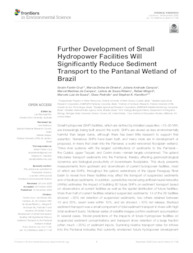Further development of small hydropower facilities will significantly reduce sediment transport to the Pantanal wetland of Brazil.
Further development of small hydropower facilities will significantly reduce sediment transport to the Pantanal wetland of Brazil.
Autoria: FANTIN-CRUZ, i.; OLIVEIRA, M. D. de; CAMPOS, J. A.; CAMPOS, M. M. de; RIBEIRO, L. de S.; MINGOTI, R.; SOUZA, M. L. de; PEDROLLO, O.; HAMILTON, S. K.
Resumo: Small hydropower (SHP) facilities, which are defined by installed capacities <10?50 MW, are increasingly being built around the world. SHPs are viewed as less environmentally harmful than larger dams, although there has been little research to support that assertion. Numerous SHPs have been built, and many more are in development or proposed, in rivers that drain into the Pantanal, a world-renowned floodplain wetland. Three river systems with the largest contributions of sediments to the Pantanal? the Cuiabá, upper Taquari, and Coxim rivers?remain largely undammed. The upland tributaries transport sediments into the Pantanal, thereby affecting geomorphological dynamics and biological productivity of downstream floodplains. This study presents measurements from upstream and downstream of current hydropower facilities, most of which are SHPs, throughout the upland watersheds of the Upper Paraguay River basin to reveal how these facilities may affect the transport of suspended sediments and of bedload sediments. In addition, a predictive model using artificial neural networks (ANNs) estimates the impact of building 80 future SHPs on sediment transport based on observations at current facilities as well as the spatial distribution of future facilities. More than half of current facilities retained suspended sediments: 14 of the 29 facilities showed >20% net retention of suspended sediments, two others retained between 10 and 20%, seven were within 10%, and six showed >10% net release. Bedload sediment transport was a small component of total sediment transport in rivers with high total sediment loads. Multiyear series of satellite images confirm sediment accumulation in several cases. Model predictions of the impacts of future hydropower facilities on suspended sediment concentrations and transport show retention of a large fraction (often much >20%) of sediment inputs. Summing riverine transport rates for inflows into the Pantanal indicates that currently envisioned future hydropower development would reduce the suspended sediment transport by 62% from the current rate. This study shows that if SHPs are built on sediment-rich rivers, this may prove problematic for the facilities as well as for downstream ecosystems. These results support recommendations that several river systems presently lacking dams in their lower reaches should be excluded from future hydropower development to maintain the sediment supply to the Pantanal.
Ano de publicação: 2020
Tipo de publicação: Artigo de periódico
Unidade: Embrapa Pantanal
Palavras-chave: Barragem, Dams (hydrology), Hidrelétrica, Hydroelectric power, Sedimento, Sediments
Observações
1 - Por padrão são exibidas publicações dos últimos 20 anos. Para encontrar publicações mais antigas, configure o filtro ano de publicação, colocando o ano a partir do qual você deseja encontrar publicações. O filtro está na coluna da esquerda na busca acima.
2 - Para ler algumas publicações da Embrapa (apenas as que estão em formato ePub), é necessário ter, no celular ou computador, um desses softwares gratuitos. Sistemas Android: Google Play Livros; IOS: iBooks; Windows e Linux: software Calibre.
Acesse outras publicações
Acesse a Base de Dados da Pesquisa Agropecuária (BDPA) para consultar o acervo completo das bibliotecas da Embrapa.

